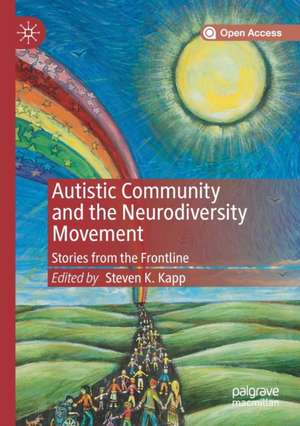Autistic Community and the Neurodiversity Movement: Stories from the Frontline
Editat de Steven K. Kappen Limba Engleză Paperback – 11 sep 2020
This open access book marks the first historical overview of the autism rights branch of the neurodiversity movement, describing the activities and rationales of key leaders in their own words since it organized into a unique community in 1992. Sandwiched by editorial chapters that include critical analysis, the book contains 19 chapters by 21 authors about the forming of the autistic community and neurodiversity movement, progress in their influence on the broader autism community and field, and their possible threshold of the advocacy establishment. The actions covered are legendary in the autistic community, including manifestos such as “Don’t Mourn for Us”, mailing lists, websites or webpages, conferences, issue campaigns, academic project and journal, a book, and advisory roles. These actions have shifted the landscape toward viewing autism in social terms of human rights and identity to accept, rather than as a medical collection of deficits and symptoms to cure.
| Toate formatele și edițiile | Preț | Express |
|---|---|---|
| Paperback (1) | 389.88 lei 6-8 săpt. | |
| Springer Nature Singapore – 11 sep 2020 | 389.88 lei 6-8 săpt. | |
| Hardback (1) | 426.72 lei 6-8 săpt. | |
| Springer Nature Singapore – 19 noi 2019 | 426.72 lei 6-8 săpt. |
Preț: 389.88 lei
Nou
Puncte Express: 585
Preț estimativ în valută:
74.61€ • 77.45$ • 62.21£
74.61€ • 77.45$ • 62.21£
Carte tipărită la comandă
Livrare economică 22 martie-05 aprilie
Preluare comenzi: 021 569.72.76
Specificații
ISBN-13: 9789811384394
ISBN-10: 9811384398
Pagini: 352
Ilustrații: XIX, 330 p. 7 illus., 6 illus. in color.
Dimensiuni: 148 x 210 x 20 mm
Greutate: 0.46 kg
Ediția:1st ed. 2020
Editura: Springer Nature Singapore
Colecția Palgrave Macmillan
Locul publicării:Singapore, Singapore
ISBN-10: 9811384398
Pagini: 352
Ilustrații: XIX, 330 p. 7 illus., 6 illus. in color.
Dimensiuni: 148 x 210 x 20 mm
Greutate: 0.46 kg
Ediția:1st ed. 2020
Editura: Springer Nature Singapore
Colecția Palgrave Macmillan
Locul publicării:Singapore, Singapore
Cuprins
Foreword.- Introduction.- Part I: Gaining Community.- 1. Historicizing Jim Sinclair’s “Don’t Mourn for Us”: A Cultural and Intellectual History of Neurodiversity’s Origins.- 2. From Exclusion to Acceptance: Independent Living on the Autistic Spectrum.- 3. Autistic People Against Neuroleptic Abuse.- 4. Autistics.org and Finding our Voices as an Activist Movement.- 5. Losing.- Part II: Getting Heard.- 6. Neurodiversity.com: A Decade of Advocacy.- 7. Autscape.- 8. The Autistic Genocide Clock.- 9. Shifting the System: AASPIRE and the Loom of Science and Activism.- 10. Out of Searching Comes New Vibrance.- 11. Two Winding Parent Paths to Neurodiversity Advocacy.- 12. Lobbying Autism’s Diagnostic Revision in the DSM-5.- 13. Torture in the Name of Treatment: The Mission to Stop the Shocks in the Age of Deinstitutionalization.- 14. Autonomy, the Critical Journal of Interdisciplinary Autism Studies.- 15. My Time with Autism Speaks.- 16. Covering the Politics of Neurodiversity: And Myself.-17. “A Dream Deferred” No Longer: Backstory of the First Autism and Race Anthology.- Part III: Entering the Establishment?.- 18. Changing Paradigms: The Emergence of the Autism/Neurodiversity Manifesto.- 19. From Protest to Taskforce.- Part IV.- 20. Critiques of the Neurodiversity Movement.- 21. Conclusion.
Notă biografică
Steven K. Kapp is a Research Fellow in Sociology at the University of Exeter, UK, working on the Wellcome Trust-funded project Exploring Diagnosis: Autism and Neurodiversity. With backgrounds in public policy, education, psychology, and disability studies, he researches the lived experiences, support needs, and quality of life of autistic people.
Textul de pe ultima copertă
This open access book marks the first historical overview of the autism rights branch of the neurodiversity movement, describing the activities and rationales of key leaders in their own words since it organized into a unique community in 1992. Sandwiched by editorial chapters that include critical analysis, the book contains 19 chapters by 21 authors about the forming of the autistic community and neurodiversity movement, progress in their influence on the broader autism community and field, and their possible threshold of the advocacy establishment. The actions covered are legendary in the autistic community, including manifestos such as “Don’t Mourn for Us”, mailing lists, websites or webpages, conferences, issue campaigns, academic project and journal, a book, and advisory roles. These actions have shifted the landscape toward viewing autism in social terms of human rights and identity to accept, rather than as a medical collection of deficits and symptoms to cure.
Caracteristici
The first book to bring together a large collection of neurodiverse contributors to talk about events that shaped the movement, and which they themselves were involved with Focuses on activists’ direct experience effecting change for people who identify as autistic rather than abstract accounts that reflect on autism’s social construction or essence Provides a one-stop shop for readers interested in the history and ideas of the neurodiversity movement and how these ideas have shaped production of expert and especially lay knowledge about autism Gathers a collective of autistic activist/academic voices and engages in current theoretical debates around knowledge production and epistemic authority within (critical) research on autism
